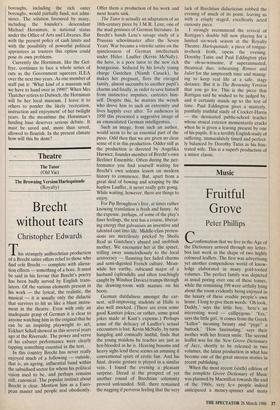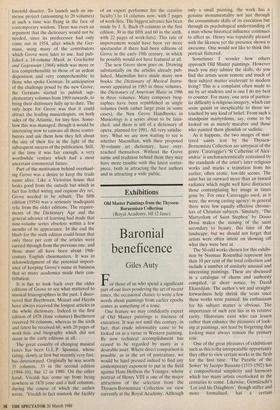Music
Fruitful Grove
Peter Phillips
Confirmation that we live in the Age of the Dictionary arrived through my letter- box last week in the shape of two highly coloured leaflets. The first was advertising yet another compendious world of know- ledge elaborated in many gold-tooled volumes. The perfect family was depicted as usual poring over one of these tomes, while the remaining 199 were artfully lying about the room evidently being enjoyed in the luxury of these erudite people's own home. I long to give them words: 'Oh look, Daddy,' says the little boy, 'here's an interesting word — callipygous."Yes,' says the little girl, 'it comes from the Greek "kallos" meaning beauty and "pyge" a buttock.' How fascinating,' says their mother with her frozen smile. The second leaflet was for the New Grove Dictionary of Jazz, shortly to be released in two volumes, the latest production in what has become one of the great success stories in recent publishing.
When the most recent (sixth) edition of the complete Grove Dictionary of Music was planned by Macmillan towards the end of the 1960s, very few people indeed anticipated a money-spinner and many foretold disaster. To launch such an im- mense project (amounting to 20 volumes) at such a time was flying in the face of contemporary wisdom. There was even an argument that the dictionary would not be needed, since its predecessor had only come out in 1954, after which the Ger- mans, using many of the contributors which Grove were later to use, had pub- lished a 14-volume Musik in Geschichte and Gegenwart (1968) which was more or less comprehensible to those of an ardent disposition and very comprehensible to those who spoke German. In anticipation of the challenge posed by the new Grove, the Germans started to publish sup- plementary volumes from 1969 onwards, to bring their dictionary fully up to date. The only hope for Grove was that it could attract the leading musicologists, on both sides of the Atlantic, for tiny fees. Some- how this was managed, though it would be interesting now to canvass all those contri- butors and .ask them how they felt about the size of their fee in the light of the subsequent success of the publication. Still, at the time it was fair enough, a very worthwhile venture which had a most uncertain commercial future.
Part of the motivation behind overhaul- ing Grove was a desire to keep the trade name alive. Like a Victorian house that looks good from the outside but which in fact has lethal wiring and copious dry rot, Grove needed to be rebuilt. The fifth edition (1954) was a seriously inadequate relic from the older editions. The require- ments of the Dictionary Age and the general advance of learning had made that nine-volume series obsolete within a few months of its appearance. In the end the blurb for the sixth edition could boast that only three per cent of the articles were carried through from the previous one, and those must all have been about 19th- century English choirmasters. It was in acknowledgment of the potential import- ance of keeping Grove's name in business that so many academics made their con- tribution.
It is fun to look back over the older editions of Grove to see what mattered to musical lexicographers in the past. I disco- vered that Beethoven, Mozart and Haydn have always received the longest articles in the whole dictionary. Indeed in the first edition of 1878 (four volumes) Beethoven received 94 columns, whereas in the sixth and latest he received 68, with 20 pages of work-lists and biography which did not occur in the early editions at all.
The great casualty of changing musical tastes has been G.L.P. Spontini, whose rating, slowly at first but recently very fast, has deteriorated. Originally he was worth 35 columns, 33 in the second edition (1904-10), but 12 in 1980. On the other hand, Vivaldi has come up from being nowhere in 1878 (one and a half columns, during the course of which the author wrote, 'Vivaldi in fact mistook the facility of an expert performer for the creative faculty') to 14 columns now, with 7 pages of work-lists. The biggest advance has been made by J. S. Bach (9 columns in the first edition, 30 in the fifth and 60 in the sixth, with 22 pages of work-lists). This rate of improvement would have been yet more spectacular if there had been editions of Grove in the early 19th century, in which he possibly would not have featured at all.
The new Grove show goes on. Drawing substantially on the articles already pub- lished, Macmillan have made many new books: the Dictionary of Musical Instru- ments appeared in 1985 in three volumes, the Dictionary of American Music in 1986 in three volumes. Many composer biog- raphies have been republished as single volumes (with rather large print in some cases), the New Grove Handbooks in Musicology is a series about to be laun- ched, and there is tell of a dictionary of opera, planned for 1991. All very satisfac- tory. What we are now waiting to see is whether Macmillan, with their proposed 30-volume art dictionary, have over- reached themselves. Without the Grove name and tradition behind them they may have more trouble with this latest centre- piece, both in attracting the best authors and in attracting a wide public.



















































 Previous page
Previous page